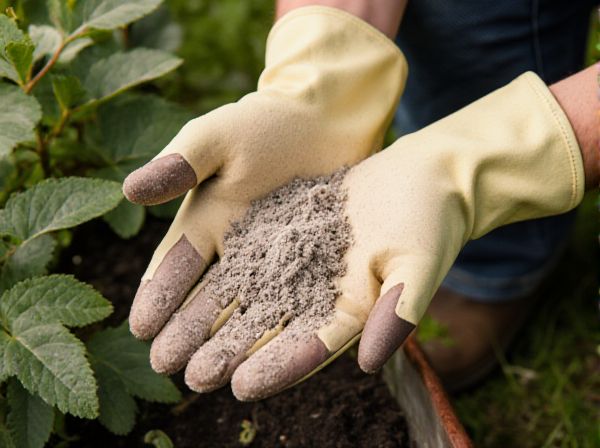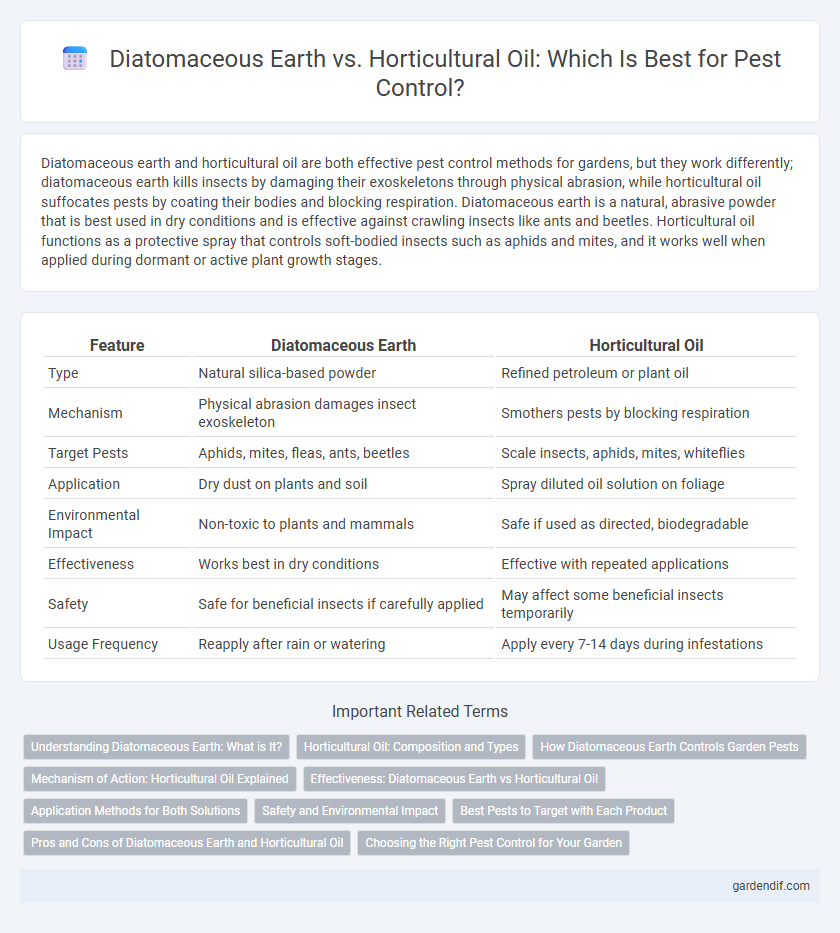
Diatomaceous earth vs horticultural oil Illustration
Diatomaceous earth and horticultural oil are both effective pest control methods for gardens, but they work differently; diatomaceous earth kills insects by damaging their exoskeletons through physical abrasion, while horticultural oil suffocates pests by coating their bodies and blocking respiration. Diatomaceous earth is a natural, abrasive powder that is best used in dry conditions and is effective against crawling insects like ants and beetles. Horticultural oil functions as a protective spray that controls soft-bodied insects such as aphids and mites, and it works well when applied during dormant or active plant growth stages.
Table of Comparison
| Feature | Diatomaceous Earth | Horticultural Oil |
|---|---|---|
| Type | Natural silica-based powder | Refined petroleum or plant oil |
| Mechanism | Physical abrasion damages insect exoskeleton | Smothers pests by blocking respiration |
| Target Pests | Aphids, mites, fleas, ants, beetles | Scale insects, aphids, mites, whiteflies |
| Application | Dry dust on plants and soil | Spray diluted oil solution on foliage |
| Environmental Impact | Non-toxic to plants and mammals | Safe if used as directed, biodegradable |
| Effectiveness | Works best in dry conditions | Effective with repeated applications |
| Safety | Safe for beneficial insects if carefully applied | May affect some beneficial insects temporarily |
| Usage Frequency | Reapply after rain or watering | Apply every 7-14 days during infestations |
Understanding Diatomaceous Earth: What is It?
Diatomaceous earth is a natural, abrasive substance composed of fossilized remains of diatoms, used as an effective pest control agent by damaging the exoskeletons of insects, leading to dehydration. Unlike horticultural oil, which smothers pests by coating their bodies, diatomaceous earth works through a physical mechanism that pests cannot develop resistance to. Its non-toxic, chemical-free nature makes it suitable for organic gardening and safe around beneficial insects when applied correctly.
Horticultural Oil: Composition and Types
Horticultural oil primarily consists of highly refined petroleum oils or neem oil, designed to suffocate pests by coating their bodies and disrupting respiration. Different types include dormant oils used during plant dormancy periods to control overwintering insects, and summer oils formulated for application during active growth stages to target soft-bodied insects and mites without damaging plants. The choice between mineral-based and botanical oils depends on the pest species, plant sensitivity, and environmental considerations.
How Diatomaceous Earth Controls Garden Pests
Diatomaceous earth controls garden pests by physically damaging their exoskeletons, causing dehydration and death through its abrasive microscopic silica particles. It is effective against soft-bodied insects like aphids, slugs, and mites by adhering to their bodies and disrupting their protective outer layers. This natural pest control method provides a chemical-free alternative that reduces pest populations without harming beneficial insects or plants.
Mechanism of Action: Horticultural Oil Explained
Horticultural oil controls pests by suffocating insects and their eggs through a thin, oily film that disrupts their respiratory function. Acting as a physical barrier, the oil interferes with the pest's cuticle, causing dehydration and death. Unlike diatomaceous earth, which abrades the exoskeleton, horticultural oil relies on its smothering mechanism to effectively manage aphids, mites, and scale insects.
Effectiveness: Diatomaceous Earth vs Horticultural Oil
Diatomaceous earth is highly effective as a mechanical insecticide, causing dehydration and death in pests by damaging their exoskeletons, especially targeting soft-bodied insects like aphids and mites. Horticultural oil works by suffocating insects and disrupting their cellular function, providing rapid knockdown of scale insects, whiteflies, and spider mites. Effectiveness depends on pest type and application method, with diatomaceous earth offering long-lasting residual control in dry conditions, while horticultural oil requires thorough coverage and may need repeated applications for sustained results.
Application Methods for Both Solutions
Diatomaceous earth is applied as a dry powder directly onto plants and soil, creating a physical barrier that dehydrates pests upon contact, while horticultural oil is sprayed as a liquid coating to smother insects and disrupt their respiration. The granular form of diatomaceous earth requires dry conditions for effectiveness and often needs reapplication after rain, whereas horticultural oil is best applied during dormant or early growth stages and requires thorough coverage for maximum pest control. Both methods target a broad range of pests but differ in their mechanisms and optimal application timing for garden or crop protection.
Safety and Environmental Impact
Diatomaceous earth is a natural, non-toxic substance made from fossilized algae that safely controls pests by physically damaging their exoskeletons without harming beneficial insects or pollinators. Horticultural oil, derived from refined petroleum or plant oils, suffocates pests but requires careful application to avoid potential phytotoxicity and harm to aquatic life if runoff occurs. Both options present eco-friendly alternatives to synthetic pesticides, with diatomaceous earth preferred for its minimal environmental impact and broad safety margin.
Best Pests to Target with Each Product
Diatomaceous earth excels at targeting crawling insects like ants, bed bugs, and flea beetles by damaging their exoskeletons and causing dehydration. Horticultural oil primarily targets soft-bodied pests such as aphids, mites, whiteflies, and scale insects by suffocating them through oil-coated surfaces. Selecting between these pest control agents depends on the specific pest species present in the garden or home environment to ensure effective management.
Pros and Cons of Diatomaceous Earth and Horticultural Oil
Diatomaceous earth provides a natural, non-toxic option for pest control by physically damaging insect exoskeletons, but it loses effectiveness when wet and can harm beneficial insects. Horticultural oil smothers pests and eggs while being safe for most plants, yet excessive application risks leaf burn and may require repeat treatments for persistent infestations. Both methods offer eco-friendly alternatives, but their efficacy depends on specific pest types and environmental conditions.
Choosing the Right Pest Control for Your Garden
Diatomaceous earth effectively targets crawling insects by physically damaging their exoskeletons, making it ideal for managing pests like ants, slugs, and beetles in the garden. Horticultural oil suffocates soft-bodied insects such as aphids, mites, and whiteflies by blocking their breathing pores, providing a broad-spectrum and less abrasive option. Selecting the right pest control depends on the specific pest problem, plant sensitivity, and environmental conditions to ensure effective and eco-friendly garden management.
Diatomaceous earth vs horticultural oil Infographic

 gardendif.com
gardendif.com